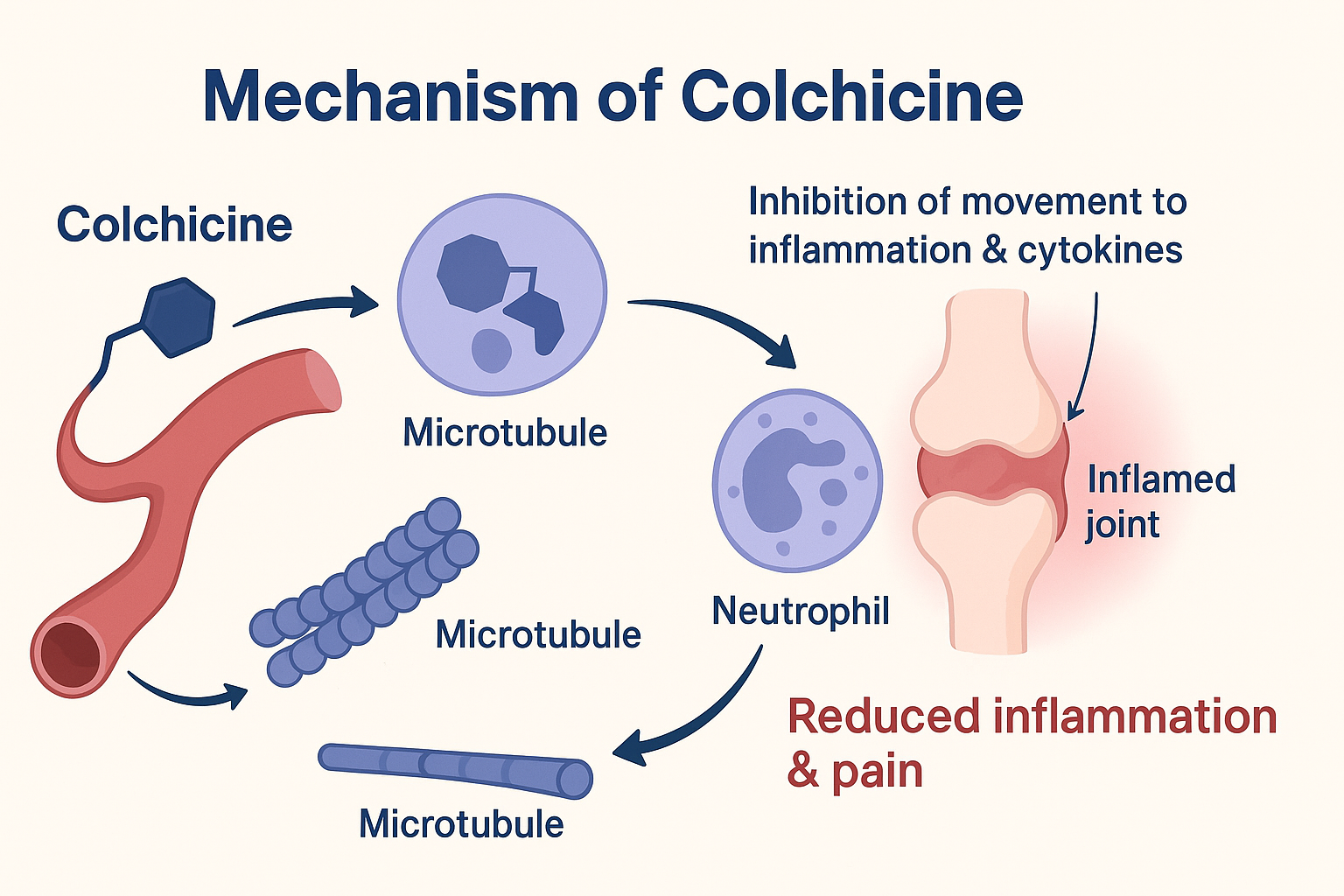Table of Contents
Introduction
Colchicine is an anti-inflammatory drug primarily used in the management of acute gouty arthritis, familial Mediterranean fever, and sometimes in pericarditis. It is not an analgesic or uric acid–lowering agent, but it inhibits leukocyte activity, which is key to managing gout flare-ups. Given its unique mechanism, narrow therapeutic window, and exam relevance, colchicine is a high-yield topic for students preparing for USMLE, NCLEX, GPAT, NAPLEX, and NEET-PG.
Mechanism of Action of Colchicine: Step-by-Step
- Binds to tubulin in neutrophils
Colchicine binds to β-tubulin, preventing its polymerization into microtubules. - Inhibits microtubule assembly
This action disrupts cytoskeletal function in neutrophils, affecting motility and phagocytosis. - Blocks neutrophil migration and activation
Neutrophils cannot migrate to the site of inflammation, nor effectively engulf urate crystals. - Inhibits inflammasome and cytokine release
Colchicine blocks the NLRP3 inflammasome, reducing release of IL-1β, a key pro-inflammatory cytokine in gout. - Result: Reduced inflammation in gout
The drug’s action lowers inflammation and relieves the symptoms of an acute gout attack without altering uric acid levels.
Pharmacokinetic Parameters of Colchicine
| Parameter | Value |
|---|---|
| Bioavailability | ~45% (oral) |
| Half-life | 9 hours (prolonged in renal/hepatic impairment) |
| Protein binding | ~40% |
| Metabolism | Hepatic (CYP3A4) |
| Excretion | Renal and fecal |
| Therapeutic index | Narrow (toxicity risk is high) |
Clinical Uses of Colchicine
- Acute gout attacks
- Prophylaxis of gout flares (during urate-lowering therapy initiation)
- Familial Mediterranean Fever (FMF)
- Pericarditis (in combination with NSAIDs)
- Behçet’s disease (off-label)
Adverse Effects of Colchicine
- GI upset (nausea, vomiting, diarrhea – most common)
- Myopathy and rhabdomyolysis (especially with statins or renal disease)
- Bone marrow suppression
- Hepatotoxicity
- Alopecia
- Toxicity with CYP3A4 or P-gp inhibitors (e.g., clarithromycin)
Comparative Analysis: Colchicine vs NSAIDs in Gout
| Feature | Colchicine | NSAIDs |
|---|---|---|
| Mechanism | Blocks neutrophil activity | Inhibits COX enzymes (prostaglandins) |
| Onset of action | Slower (within hours) | Rapid (minutes–hours) |
| Uric acid effect | No effect | No effect |
| Adverse effects | GI, myopathy, marrow suppression | GI bleeding, renal toxicity |
| Preferred use | When NSAIDs are contraindicated | First-line (in absence of contraindication) |
Practice MCQs
Q1. Colchicine primarily acts by:
a. Inhibiting xanthine oxidase
b. Blocking COX-2
c. Inhibiting microtubule polymerization ✅
d. Enhancing uric acid excretion
Q2. The target site of colchicine in neutrophils is:
a. Nucleus
b. β-tubulin ✅
c. DNA
d. Lysosome
Q3. Which cytokine’s release is suppressed by colchicine?
a. IL-6
b. TNF-α
c. IL-1β ✅
d. IL-10
Q4. Which condition is a major adverse effect of colchicine overdose?
a. Hypertension
b. Liver cirrhosis
c. Bone marrow suppression ✅
d. Anaphylaxis
Q5. Colchicine is preferred over NSAIDs in gout when:
a. Patient is elderly
b. Patient has renal failure ✅
c. Uric acid is normal
d. First-time gout flare
Q6. Colchicine is metabolized via:
a. CYP3A4 ✅
b. CYP2D6
c. CYP1A2
d. CYP2C19
Q7. Which condition increases colchicine toxicity risk?
a. Hypoglycemia
b. Renal impairment ✅
c. Hypernatremia
d. Anemia
Q8. Which of the following is not a clinical use of colchicine?
a. Familial Mediterranean fever
b. Rheumatoid arthritis ✅
c. Pericarditis
d. Acute gout
Q9. What’s the therapeutic window of colchicine?
a. Broad
b. Moderate
c. Narrow ✅
d. None
Q10. Combining colchicine with which drug raises toxicity risk?
a. Furosemide
b. Atorvastatin ✅
c. Paracetamol
d. Ibuprofen
FAQs
Q1: Does colchicine reduce uric acid levels?
No, it only reduces inflammation. It does not affect serum uric acid.
Q2: Can colchicine be used during a gout flare?
Yes, it’s especially effective if taken early during a flare.
Q3: Is colchicine safe in pregnancy?
It’s category C; used in FMF under physician supervision but with caution.
Q4: Can colchicine be combined with allopurinol?
Yes, colchicine is often used for gout flare prophylaxis when starting urate-lowering therapy like allopurinol.
Q5: How is colchicine toxicity managed?
There’s no antidote. Supportive care, GI decontamination, and monitoring are essential.
References
- KD Tripathi – Essentials of Medical Pharmacology
- Goodman & Gilman – The Pharmacological Basis of Therapeutics
- Sparsh Gupta – Review of Pharmacology
- NCBI: https://www.ncbi.nlm.nih.gov/books/NBK538223/
I am pursuing MBA in pharmaceutical management from NIPER Hyderabad with a strong academic record and proven success in national-level pharmacy entrance exams. I secured AIR 61 in NIPER 2024 (MS/M.Pharm) and AIR 27 in NIPER MBA, along with AIR 147 in GPAT 2024 and AIR 907 in GPAT 2023. I also achieved AIR 6 in AIIMS CRE-2025 for Drug Store Keeper and was selected as a Pharmacist (AIR 61) for ESIC. Additionally, I was the Runner-Up in Round 2 of the EY Case Study Competition.
At PharmacyFreak.com, I aim to guide future pharmacists through expert content, exam strategies, and insightful resources based on real experience and academic excellence.
Mail- harsh@pharmacyfreak.com
